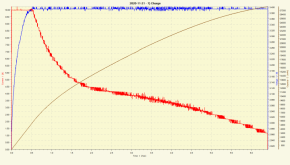My 280ah Lischen cells are in 16s configuration and I will be put into service soon on my 5,500 watt off grid inverter. My charging does not go through my Orion BMS so I need to be specific with my charge setting. I'd like to keep things between 15 -85 % SOC since I don't need anywhere close to 280ah. Please let me know if my plan based upon Will's recommendations sounds about right. Thanks for any advice.
Solar Charge Controller
Bulk: 56.4v
Absorb: 56.4v (absorb time set to 1 minute)
Float: 54.4v (so the sun powers the loads instead of the batteries)
Inverter charger (for generator charging)
Bulk 56.4v
Absorb: 56.4v (absorb time set to 1 minute)
Float disabled
LBCO 48v (that's as high as my inverter will allow)
HBCO: 58v (that's as low as my inverter will allow)
Temperature compensation set to 0 on both solar charger and inverter charger.
Once I get my Orion BMS talking to my equipment I will set up the LBCO, HBCO and temperature cutoff as failsafe settings.
Solar Charge Controller
Bulk: 56.4v
Absorb: 56.4v (absorb time set to 1 minute)
Float: 54.4v (so the sun powers the loads instead of the batteries)
Inverter charger (for generator charging)
Bulk 56.4v
Absorb: 56.4v (absorb time set to 1 minute)
Float disabled
LBCO 48v (that's as high as my inverter will allow)
HBCO: 58v (that's as low as my inverter will allow)
Temperature compensation set to 0 on both solar charger and inverter charger.
Once I get my Orion BMS talking to my equipment I will set up the LBCO, HBCO and temperature cutoff as failsafe settings.




